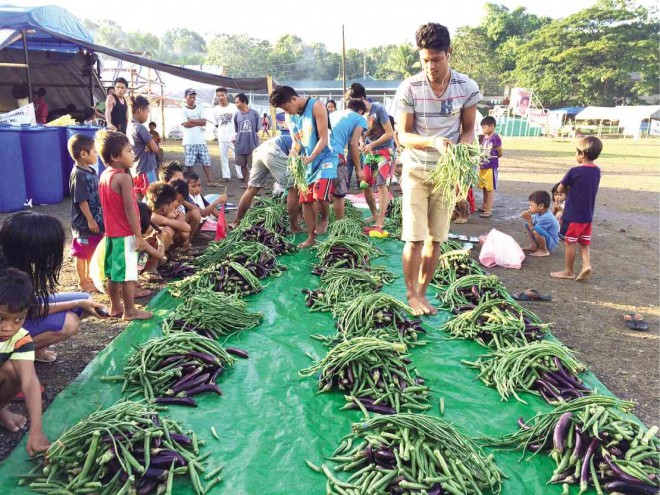‘Lumad’ evacuees just want to go home

Young men divide the vegetables donated for the evacuees now staying at the sports complex in Tandag City in Surigao del Sur province. NICO ALCONABA
Several groups of children kneel on the almost grassless football field at Surigao del Sur Sports Complex.
Each group forms a circle as the children participate in the psychosocial poster-making workshop facilitated by the Philippine Red Cross (PRC).
“The only instruction given was for them to draw whatever they wanted to,” a PRC staff member said.
But all the groups seem to have one theme. All of them drew houses.
“We want to go home,” a group of girls chorused when asked by the Inquirer to explain their work.
Article continues after this advertisementFor now, however, the girls, and almost 3,000 others, have to stay at the sports complex. They fled their homes following the Sept. 1 killing of Emerito Samarca, executive director of Alternative Learning Center for Agriculture and Livelihood Development (Alcadev), and two “lumad” leaders Dionel Campos and Datu Bello Sinzo in Sitio Han-ayan in the village of Diatagon, Lianga town.
Article continues after this advertisementThe evacuees, totaling 2,971 as of Saturday afternoon, came from 26 communities of seven villages in five towns in Surigao del Sur province. Most of them stay on the bleachers of the sports complex, while some have set up makeshift tents on the football field.
As early as 4 a.m., white smoke ascends from the ground below the bleachers and in between tents as several evacuees start cooking breakfast.
At the same time, a number of people fetch water from the Red Cross potable water collection points, while some bathe at water drums nearby.
The evacuees are awakened by the alternating sounds of splashing water and firewood chopping.
At 5 a.m., an old woman, as if flexing her muscles, dances to the “One Billion Rising” song that comes from a parked pedicab’s sound system.
Before the sun rises, practically everybody’s up.
Outside the tent of Bread for Emergency Assistance and Development, or BREAD, young men start to divide the six sacks of eggplant, string beans and okra. These will be distributed to the “budgeter” of each of the 27 communities. The “budgeter,” the one tasked to get a community’s daily food ration, will then equally divide the food supply per family.
Ryan Recalde, who takes the morning shift at the Bread tent, said they needed at least 45 sacks of rice per day to feed the evacuees.
“The provincial governor, the city government and several private groups help us,” he said.
Next to the Bread tent is the “clinic” of Community-Based Health Program (CBHP), where a mother has her son checked.
“He wasn’t able to sleep because of his headache,” the mother said of her teenage son.
Since Sept. 1, when the evacuees arrived here, CBHP has recorded 722 people who were suffering from colds, cough, diarrhea and sore eyes. At least 45 patients have been admitted to the nearby provincial hospital.
Beside the Bread tent, Rogelio Montero leads a number of men in building a tent that will serve as the “staff house” for those who oversee the welfare of the evacuees.
Montero and the men have just unloaded the bamboo poles donated by a community of farmers.
“We try to help as much as we can. In fact, we just distributed 38 sacks of used clothing. We may be poor but we can also help,” said Montero, president of Kapunungan sa mga Mag-uuma sa Surigao del Sur.
At 8 a.m., children start to gather outside the Bread and CBHP tents. They are students of Alcadev and the tribal community schools run by Tribal Filipino Program of Surigao del Sur. In front of them are three girls—two holding the Philippine flag, while the other says: “‘Bayang Magiliw,’ handa, awit.”
After singing the national anthem, the children recited “Panunumpa sa Watawat (Pledge to the Flag).” This is followed by the usual morning exercises—head rotation, head bending, shoulder rotation, hip rotation, hip bending and jumping jacks. Then, off they go to school—two makeshift tents and the bleachers.
Tents set up by the government’s Departments of Health, and Social Welfare and Development also start accepting “clients.”
Before noon, outsiders, bringing in food, enter the sports complex. This time, they are the nuns from San Pedro College of Davao and the volunteers from Art Relief Mobile Kitchen led by photojournalist Alex Baluyot.
In the afternoon, fire trucks deliver water while young boys play basketball on two courts.
As the sun sets, white smoke again ascends from the ground below the bleachers and from the makeshift tents as the evacuees prepare dinner—mostly consisting of rice, noodles and vegetables.
Then they will go to sleep, and will be awakened, again, by the sound of firewood chopping and water splashing.
And, yes, there will still be early morning music from the parked pedicab. Songs like “One Billion Rising,” Gary Granada’s “Pana-Panahon” and even Katy Perry’s “Last Friday Night.”